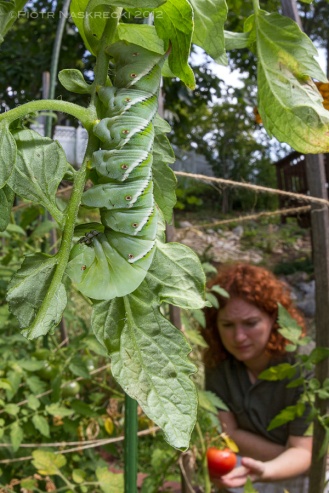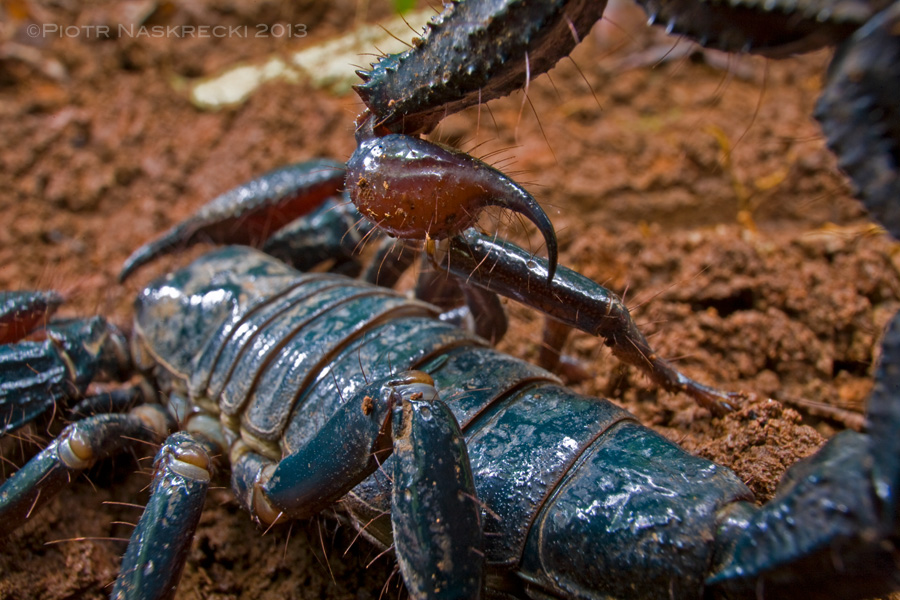
Shortly after I had become a proud owner of my first real SLR camera (the wonderful Nikon n6006 – an unexpected Christmas gift from my wife), I decided that what I wanted to do with this magical piece of equipment was to document life that was two or three orders of magnitude smaller than traditional subjects of nature photography. But I wasn’t satisfied with simple macro portraits of katydids and frogs –I was desperate to capture their environment as well, and show a clump of lichens the way a fly sees it – a towering forest, three dimensional, and complex. This, of course, turned out to be easier said than done.
Ever since I saw David Attenborough’s “Trials of Life”, and the mind-boggling sequence of weaver ants tending caterpillars (to this day this remains one of the best macro sequences ever filmed – if you haven’t seen it, buy it right now), I have been obsessed with trying to photograph insects and other small organisms in a way that removes the element of scale. I want to show them as part of the landscape, and see the world from their perspective. It took me a while to figure out that the way to do it is to forget about macro lenses, but instead use lenses designed for much, much larger subjects: wide angle lenses traditionally used for landscape photography. These are lenses of the focal length shorter than 50mm. After many years of trying to get a hang of wide-angle macrophotography I am still hoping to improve my results, but at least I have been able to isolate and try to work on those elements that are needed for a good a wide-angle macro shot. Here are a few tips based on my experience so far.

Perspective. What truly makes a good wide-angle shot is the impression that you, the viewer, are standing right inside the frame, and that you are looking at the world from the perspective of a mouse. Macro photography that uses lenses of the focal length longer than 50mm enlarges the subject, but a macro photograph taken with a lens shorter than 50mm shrinks the viewer. The shorter the lens the more striking the effect of “shrinkage”, and it is amplified by a low angle of the photo. For example, we never see mushrooms from below, looking up at their underside, and such a perspective enhances the impression of suddenly being transported to the world of towering, giant mushrooms. My two favorite lenses that provide just the right perspective are Canon EF 16-35mm f/2.8L (often mounted on an extension tube – see below) and Canon EF 14mm f/2.8L. Occasionally I also use a Sigma 15mm f/2.8 EX DG Diagonal Fisheye, although this lens creates a very strong barrel distortion of the field of view. A very helpful piece of equipment that allows me to get a ground level point of view is the right angle viewfinder (Canon Angle Finder C).

Focus. A wide-angle photograph must have a focal point that is perfectly sharp. Unfortunately, most wide-angle lenses are not designed to focus close enough to fill the frame with subjects as small as insects. Luckily, an inexpensive extension tube can turn almost any wide-angle lens into a wide-angle macro lens. I use a Canon Extension Tube EF 12 II, which allows me to focus on and fill the frame with subjects as small as a grasshopper. The shortest lenses that can be used with it should have the focal length of 16mm or longer – if a lens is shorter than 16mm the point of focus will be inside the lens. Thus, neither Canon EF 14mm nor Sigma 15mm can be used with an extension tube, but luckily both focus close enough so that I have been able to use them to photograph subjects as small as ants (they don’t fill the frame with an individual ant, but that’s not the point of wide-angle macrophotography anyway.)

Depth of field. The sharper the objects in the background, the stronger the illusion that the frontmost, focal subject of the photo is huge (relative to you, the viewer). In order to achieve a maximum depth of field, use the shortest lens you can and stop the aperture as far down as possible. I usually use the aperture of f/16 or f/22, which means that the exposure time tends to be quite long, often 0.5-2 sec, even in the middle of the day.
————
Stay tuned for the second part of the post where I will discuss how to stabilize the camera, illuminate the scene, and select the best equipment for wide-angle macrophotography. In the meantime I highly recommend a recent e-book “Wide-Angle Macro: The Essential Guide” by Paul Harcourt Davies and Clay Bolt, which is filled with great practical information and superb examples.


Piotr
How generous of you to make so much detail and experience available for everyone. Superb work too!
Wade Hughes FRGS
Reblogged this on Philip's Blog.
I just bought the wide-angle macro book yesterday, and I don’t think you’ll find a better deal anywhere. Looking forward for Piotr’s next installment, especially if it includes how he uses flash with these wide-angle macro’s.
Hi David – thanks for all the great information. I’ll be anxious to see your book update, as I actually have a Panasonic Lumix (and can also screw a filter to a lens front)!
Piotr, let me add my thanks to Clay’s for your kind words regarding our ebook.
Nikon users, for once, have an advantage over Canon folk in that they can use an extension tube with their 15mm f/2.8 Sigma lenses – the old 8mm manual tube. The Sigma lens has a manual diaphragm and on DX format there is much less barrel distortion. I also have a 4mm tube for an old Canon FD lens system!
I have tried a Kenro 12mm tube on the Sigma lens and it does produce a ‘real’ focus but very close to the lens even when it is focused at infinity. I find it unworkable in practice
In answer to Ted C Macrae there is too much in the way of internal linkages to adjust to make it feasible to machine down a 12mm extension tube – it is something I have pondered and rejected, even though I am happy doing anything with a lathe. You might try with a cheap Chinese-made set. At most one just needs from 1- 6mm extension and there is nothing commercially available to do this with DSLRs. I have, however produced something that works very well giving extensions of from 0.5mm to 6mm is steps of 0.5mm. I have two versions that can be made by anyone with basic skills (like screwing a filter to a lens front…) and will offer it soon as a free update/add on to the wide angle macro book… you need a Panasonic Lumix or Sony NEX body, first!
I also have a 10mm Kenro fully auto tube for the Sony NEX 7 and with a 19mm Sigma lens the pairing is great for wide shots at about half life-size… these small cameras with a reduced back-focus offer huge possibilities.
Excellent post, as usual, and thanks for the mention!
I’ve been hoping you would do a post (or more) on wide angle macro. I have the Davies and Bolt book and am absorbing it, but your photos are most like what I envision/hope to do.
What do you think about machining a 12mm extension down to 6-8mm for use on a 14 or 15mm lens?